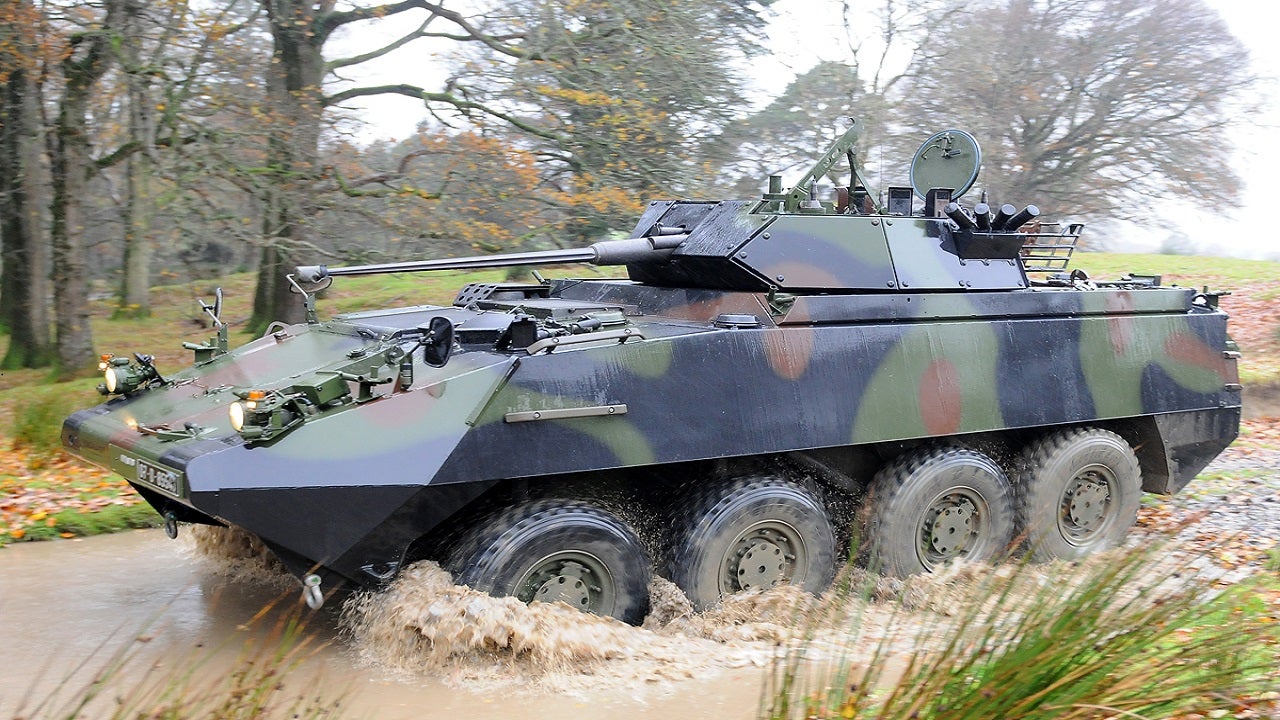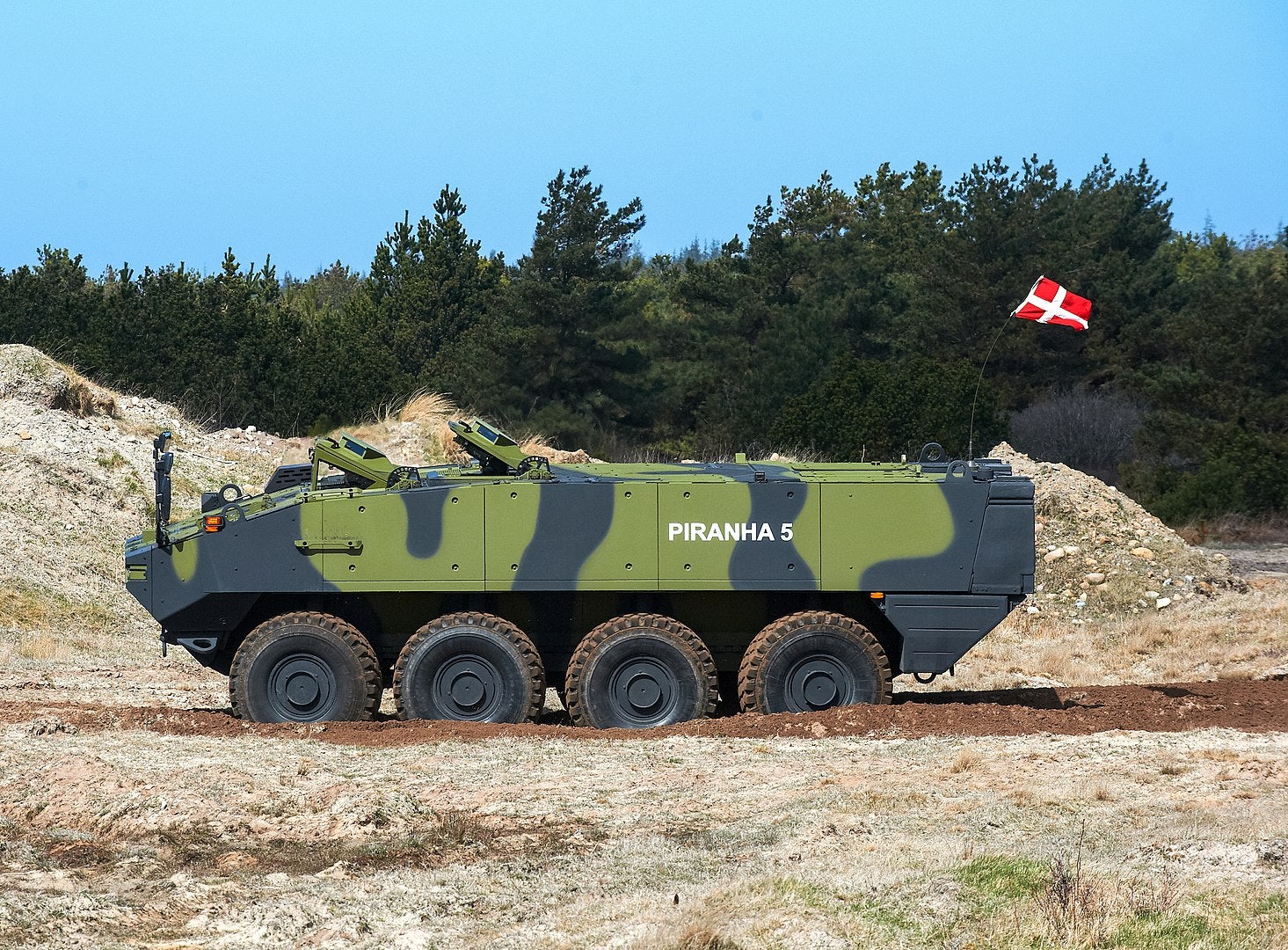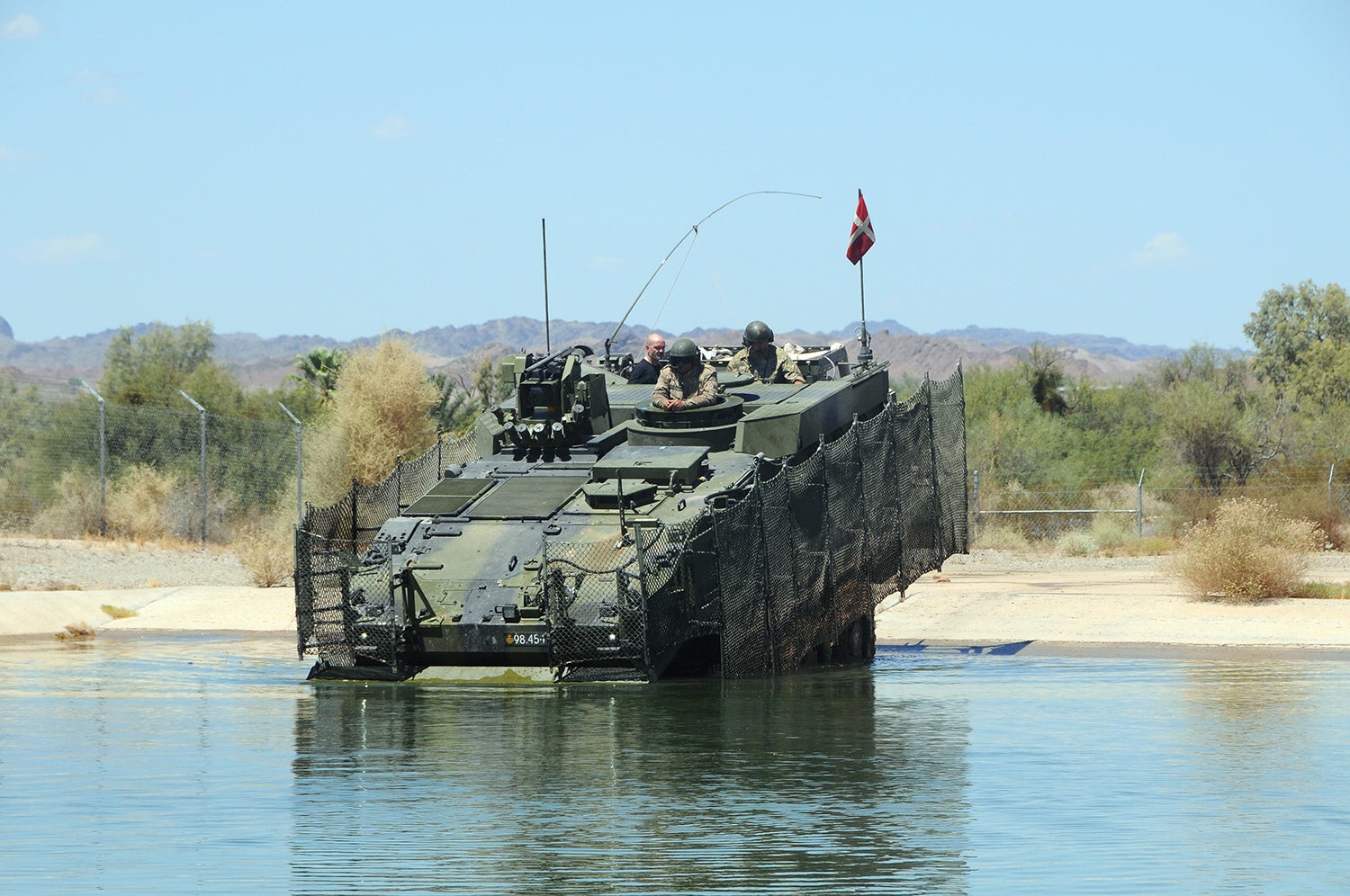The PIRANHA 5 8×8 is the fifth-generation of the family of Piranha wheeled utility vehicles and was developed by General Dynamics, using private venture funding. It was initially designed specifically to meet the UK armed forces’ future rapid effect system (FRES) requirements.
The PIRANHA 5 is a British development of a European design and therefore free of the US Department of Defense international traffic in arms regulations (ITAR) restrictions, thus simplifying its transfer into the UK to meet the UK defence industrial strategy objectives.
A large number of PIRANHA vehicles are currently deployed on operations in Iraq and Afghanistan.
Since 1996, the PIRANHA vehicles have been built in 6×6, 8×8 and 10×10 variants and by the end of 2017, more than 11,000 variants of PIRANHA vehicles were in service in more than 20 nations’ armed forces worldwide, including the US Army’s Stryker vehicle, a variant of the PIRANHA III.
The development of the PIRANHA 5 was carried out by General Dynamics UK and Mowag of Switzerland (part of the General Dynamics European Land Combat Systems group). The manufacture of the first PIRANHA V prototype was completed by the end of 2008. A PIRANHA 5 8×8 armoured personal carrier was successfully loaded into an Airbus A400M cargo aircraft during an evaluation exercise in 2016.
Orders and deliveries
The Defence Acquisition and Logistics Organisation (DALO) of the Danish Ministry of Defence signed a contract with General Dynamics European Land Systems (GDELS) for the delivery of
309 8×8 PIRANHA armoured personal carrier vehicles in 2015. The vehicles are being delivered in six different variants: engineer, infantry, ambulance, command, mortar and repair.
The first batch of PIRANHA 5 vehicles was delivered to the Royal Danish Army in March 2019.
In January 2018, GDELS received an approximately $1bn contract from the Armed Forces of Romania to supply up to 227 PIRANHA 5 armoured vehicles in six different configurations.
The first of 36 PIRANHA 5 vehicles was delivered to the Romanian Ministry of Defence in October 2020.
General Dynamics European Land Systems-Santa Bárbara Sistemas (GDELS-SBS), a joint venture of GDELS and Spanish defence contractor Santa Bárbara Sistemas, was awarded a contract worth $870m to supply 348 PIRANHA 5 combat wheeled vehicles in August 2020.
PIRANHA 5 Future Rapid Effects System (FRES) utility vehicle
In June 2007, the UK MoD announced that the PIRANHA vehicle was one of three vehicles selected for the FRES utility vehicle ‘Trials of Truth’. The PIRANHA Evolution vehicle was General Dynamics’ candidate vehicle in these trials, which were held in 2007 at the MoD’s armoured trials and development unit at Bovington. The PIRANHA Evolution vehicle was an interim design and is the basis for the development of the PIRANHA V.
The trial of the PIRANHA Evolution provided a demonstration of the potential of PIRANHA to meet the FRES threshold requirements and the stretch potential to meet the emerging and future requirements, which will develop with the armed forces’ evolving operational needs.
General Dynamics United Kingdom Limited was selected by the UK Ministry of Defence as the provisionally preferred bidder for the utility vehicle design (UVD) for the future rapid effect system. The UK MoD announced the selection in May 2008.
However, in December 2008, this preferred bidder status was withdrawn by the UK MoD citing failure to achieve agreement on commercial conditions. The MoD decided to restructure the programme. The utility vehicle competition would be restarted at a later date and the MoD stated that General Dynamics would be free to enter a revised bid.
A decision on the future of the FRES utility vehicle programme was due in the UK Government’s 2010 Strategic Defence Review, however no announcement was made. On 9 October 2012, The Telegraph newspaper quoted a senior Ministry of Defence source as saying: “FRES is dead in the water. It’s a dead duck. It is the definition of everything that is wrong with the MoD’s procurement process.”
PIRANHA 5 vehicle details
The main differences between the PIRANHA V vehicle and the current variants are: higher levels of protection, up-rated drive-train to cater for weight growth, greater internal volume,
improved mobility, enhanced power and power management and a modern, open, electronic architecture.
PIRANHA 5 has significant additional internal capacity over the existing fleet of vehicles. The additional capacity eases the burden on storage and the carriage of supporting weaponry and material.
Assisted steering is provided on the two front pairs of wheels and the rear wheels. The wheels are fitted with run flat tyres, a central tyre inflation system and anti-lock braking. The pressure of each tyre is automatically controlled at 30-second intervals. The crew can set the tyre pressure to pre-selected pressures for metalled road, cross country, sandy terrain and for emergency operation, optimising the vehicle for ride and tactical mobility.
The vehicle has the capacity to generate increased electrical power on demand and has an integrated power management system.
The power system accommodates new systems and technologies currently under development.
Weapons on board the fifth-generation PIRANHA wheeled utility vehicle PIRANHA has already demonstrated a broad range of weapon systems mounted on the platform to suit mission requirements, for example, 12.7mm, 25mm, 30mm or low-recoil 105mm guns, including Rheinmetall Landsysteme weapon station with a 12.7mm gun and Delco Systems 25mm and 30mm turrets.
Survivability
The PIRANHA 5 provides a greatly increased level of protection compared to the earlier PIRANHA variants. The improvements have benefited from direct experience of PIRANHA on operations in Iraq and Afghanistan.
The internal and external physical layout of the vehicle, the integrated mine-protected seats and a range of other survivability features are incorporated into the design.
The PIRANHA designs incorporate shaped hull plates to optimise against blast, spacing in the add-on armour and surface coatings to minimise the thermal and radar signatures.
The modular armour system provides protection against rocket-propelled grenades (RPGs), 14.5mm armour-piercing rounds through 360° and 30mm armour piercing rounds across the 30° frontal arc. The hull provides protection against 8kg anti-tank mines.
Development work has been carried out for the integration of a hard-kill defensive aids suite (HK DAS) and protection against improvised explosive devices (IEDs) on PIRANHA V.
The PIRANHA 5 has the capacity to generate increased power to enable the effective application of selected or developing survivability technologies as they become available, such as hard or soft-kill defensive aid systems or electric armour.
Command and control
The PIRANHA V and its predecessor, the PIRANHA Evolution, are fitted with the Bowman secure tactical digital communications system. The voice and data communications system does not require encoding and decoding. A global positioning system processor is integrated into each Bowman radio that updates all the other radios on the network. The system provides fast, secure, tactical digital communications and enhanced situational awareness with automatic location and navigation reporting.
The PIRANHA 5 has a fully integrated, FRES utility vehicle electronic architecture. The architecture is integrated with the battle command integration programme (BCIP), local and on-board situational awareness suite, the health and usage monitoring system (HUMS), the collective protection systems (COLPRO) and the remote weapon station.
PIRANHA 5 engine
The vehicle is powered by an MTU 6V199 TE20 diesel engine, rated at 550hp, with a ZF 7HP 902, seven-speed, electronically controlled automatic transmission. The vehicle meets European emissions standards.
The power-to-weight ratio is dependent on the mission configuration and combat weight of the vehicle and is approximately 20hp/t at 33t combat weight and with the TE20 550hp engine.
During the MoD’s trials at Bovington in 2007, the power pack was removed, reinstalled and running in less than an hour in an ease-of-maintenance assessment. The PIRANHA engine can be test run off the platform before refit.
Mobility of PIRANHA 5
The cross-country mobility of the PIRANHA 5 is similar to that of a tracked vehicle. The vehicle’s height adjustable hydro-pneumatic suspension system installed at each wheel station provides a more comfortable, faster and more fuel-efficient ride for the crew. The front and rear suspensions have a vertical travel of up to 320mm and 340mm.
The vehicle features a hydropneumatics suspension, all-wheel drive, and a four-axle steering for improved mobility compared to earlier variants of the PIRANHA family. A smaller turning radius greatly contributes to mobility where there is restricted room to operate, such as in narrow streets in urban environments, in wooded areas or in narrow wadis.
The turning radius of the PIRANHA 5, which has additionally assisted steering on both the rear wheels and the first two pairs of wheels, is 15m, which was demonstrated in the FRES trials in 2007.





